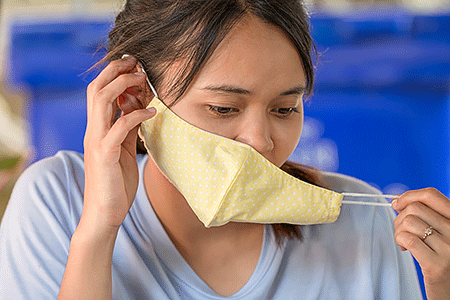Masks play a vital role in reducing the spread of the coronavirus. Masks can also be hard on your skin, causing problems that range from acne and peeling skin to rashes and itchiness. To help prevent skin problems from developing under your mask, board-certified dermatologists recommend these nine tips.
-
Cleanse and moisturize your face daily. Gentle skin care can prevent skin problems. When washing your face, use a mild, fragrance-free cleanser and follow these steps. Face washing 101
- Ceramides
-
Hyaluronic acid
-
Dimethicone (which can also create a barrier that helps reduce irritated skin)
You can prevent breakouts from your moisturizer by using a moisturizer formulated for your skin type. When selecting moisturizer, follow this guide:
-
Oily skin (or when weather is hot, humid): Gel moisturizer
-
Normal or combination skin: Lotion
-
Dry to very dry skin: Cream
If you have acne or tend to break out, you can still use a gel moisturizer.
Apply moisturizer before and after wearing a mask
Moisturizer can prevent problems, especially if you have dry or sensitive skin.

- Ceramides
-
Protect your lips by applying petroleum jelly. Dry skin and chapped lips are common face mask skin problems. You can prevent chapped lips by applying petroleum jelly to your lips:
- After washing your face
-
Before you put on your mask
-
Before bed
To prevent breakouts, take care to apply the petroleum jelly only to your lips. - After washing your face
-
Skip the makeup when wearing a mask. Beneath a mask, makeup is more likely to clog your pores and lead to breakouts. If makeup is necessary, use only products labeled “non-comedogenic” or “won't clog pores.”
-
Avoid trying new skin care products that can irritate your skin. Wearing a mask for even a short time can make your skin more sensitive. To reduce skin problems, avoid trying harsh products, such as a chemical peel, exfoliant, or retinoid, for the first time, says board-certified dermatologist Daniela Kroshinsky, MD, MPH, FAAD.
Retinoids can irritate your skin
“If you’ve been using a retinoid (or retinol), apply it at bedtime and don’t increase the amount that you apply.”

-
Use less of certain skin care products if your face becomes irritated. When you cover your face with a mask, some skin care products that you’ve used in the past may irritate your skin. If this happens, Dr. Kroshinsky recommends cutting back on products that can irritate your skin, such as:
- Leave-on salicylic acid
-
Retinoid you apply to your face
-
Aftershave

“The American Academy of Dermatology supports the Centers for Disease Control and Prevention’s recommendation to wear a cloth face covering in public settings and when around people who don’t live in your household, especially when social distancing measures are difficult to maintain. A growing body of evidence has shown that masks play a vital role in reducing the spread of COVID-19. The AAD encourages people to wear face masks in public, practice social distancing, and frequently wash your hands to help protect yourself, your family and your community.”
─ AAD President Bruce H. Thiers, MD, FAAD
- Leave-on salicylic acid
-
Wear the right mask. To reduce skin problems, look for masks that offer the following:
- A snug, but comfortable fit
-
At least two layers of fabric
-
Soft, natural, and breathable fabric, such as cotton, on the inside layer that rests against your skin
Wearing a mask that offers a snug, but comfortable fit helps to protect you and others from the coronavirus. You want a snug fit across your nose, on the sides, and under your chin.
For more tips on selecting a face mask to prevent the spread of COVID-19, visit the Centers for Disease Control and Prevention at CDC.gov/coronavirus.
- A snug, but comfortable fit
-
Take a 15-minute mask break every 4 hours. Health care workers on the frontlines of the coronavirus pandemic have found that this helps save their skin. Of course, only remove your mask when it’s safe to do so and after washing your hands.
- Outdoors, when you can stay at least six feet away from people
-
Inside your car when you’re alone
-
At home
- Outdoors, when you can stay at least six feet away from people
-
Wash your cloth masks. Many health care organizations now recommend that you wash a cloth mask after each use. Washing it also removes oils and skin cells that collect inside the mask, which could lead to a skin problem.
- Follow the washing instructions on each mask.
-
Wash the masks in hot water unless the instructions say otherwise.
-
Use a fragrance-free, hypoallergenic laundry detergent.
After washing your mask, check its shape. If a mask no longer fits snugly (and comfortably), it is less protective. - Follow the washing instructions on each mask.
-
Continue the treatment plan that your dermatologist created for you. If you have a skin condition, such as acne or rosacea, it’s especially important to follow your treatment plan. This can help keep the condition under control.
Article courtesy of American Academy of Dermatology Association

